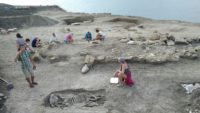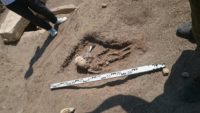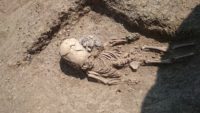 Archaeologists and student volunteers have discovered the skeletal remains of a young child with an artificially deformed cranium in a necropolis on the Kerch peninsula in eastern Crimea. The team from the Institute of Archeology of the Russian Academy of Sciences and the Archeology Foundation have been excavating the ancient necropolis of Kyz-Aul for three weeks. Several graves dating from the 1st century B.C. to the 3rd century A.D. have already been unearthed during this field season. They’ve found the remains of Sarmatian soldiers in monumental stone crypts and horse burials, but the child’s grave is the only one to feature the elongated skull characteristic of intentional cranial deformation.
Archaeologists and student volunteers have discovered the skeletal remains of a young child with an artificially deformed cranium in a necropolis on the Kerch peninsula in eastern Crimea. The team from the Institute of Archeology of the Russian Academy of Sciences and the Archeology Foundation have been excavating the ancient necropolis of Kyz-Aul for three weeks. Several graves dating from the 1st century B.C. to the 3rd century A.D. have already been unearthed during this field season. They’ve found the remains of Sarmatian soldiers in monumental stone crypts and horse burials, but the child’s grave is the only one to feature the elongated skull characteristic of intentional cranial deformation.
Researchers have confirmed from osteological analysis that the remains are those of a boy. Because his fontanelle was not fully closed, scientists were able to determine that he was around 18 months old at time of death. His remains were radiocarbon dated to the 2nd century A.D. when the peninsula was part of the Bosporan Kingdom, a Hellenistic kingdom that became a client state of the Roman Empire in 1st century. The bones are in an excellent state of preservation. Buried with the child were a clay vessel near his head and a few small beads of colored glass. The boy was wearing a copper alloy bracelet on his right wrist. He was interred directly in the ground. No remains of a coffin, gravestone or marker were found.
 The excavation team nicknamed this find “the grave of an alien” because of the skull shape, an unfortunate phrase that all of the articles in the press have glommed onto even though intentional cranial deformation has been an entirely terrestrial human phenomenon for thousands of years. Examples of it have been found in every inhabited continent, and the inhabitants of the Black Sea coast, most notably the Sarmatians, had been altering their children’s’ skull shapes for centuries by the time this little boy was born.
The excavation team nicknamed this find “the grave of an alien” because of the skull shape, an unfortunate phrase that all of the articles in the press have glommed onto even though intentional cranial deformation has been an entirely terrestrial human phenomenon for thousands of years. Examples of it have been found in every inhabited continent, and the inhabitants of the Black Sea coast, most notably the Sarmatians, had been altering their children’s’ skull shapes for centuries by the time this little boy was born.
The cranial modification process began in infancy when the bones of the skull are malleable. In the Black Sea region, people wrapped plaits around babies’ heads and over time the pressure of the wrapping changed the shape of the skull. The elongated egg shape was considered more aesthetically pleasing than the regular old boring skulls they were born with, and had important cultural and social significance because it was an attribute of the Sarmatian military nobility who were increasingly powerful in the Bosporan Kingdom. It was primarily boys destined to be elite fighters who had their skulls modified, so it’s likely this child was slated to be a Sarmatian warrior.
 The date of the child burial is a meaningful one within this context because the Sarmatian warrior elite, who mainly fought as heavy cavalry for the Bosporan Kingdom, had grown in power and influence to such a degree that by the 2nd century A.D., the formerly Hellenistic kingdom was increasingly Sarmatized. It was in the 2nd century that the last of the Greek ruling dynasties died out and was replaced by a new Sarmatian dynasty. This takeover had far-reaching cultural implications. Artisan crafts were decorated with Sarmatian motifs instead of Greek ones. Even the way people dressed changed, with trousers and long-sleeved shirts replacing the Greek tunics and gowns.
The date of the child burial is a meaningful one within this context because the Sarmatian warrior elite, who mainly fought as heavy cavalry for the Bosporan Kingdom, had grown in power and influence to such a degree that by the 2nd century A.D., the formerly Hellenistic kingdom was increasingly Sarmatized. It was in the 2nd century that the last of the Greek ruling dynasties died out and was replaced by a new Sarmatian dynasty. This takeover had far-reaching cultural implications. Artisan crafts were decorated with Sarmatian motifs instead of Greek ones. Even the way people dressed changed, with trousers and long-sleeved shirts replacing the Greek tunics and gowns.
At the same time, Sarmatians made peace with the Romans, who had been fighting them since the 1st century B.C., and in 175 A.D. negotiated a treaty with Emperor Marcus Aurelius. By the terms of the treaty, the Sarmatians agreed to send Rome 8,000 of their famed heavy cavalry. More than half of them were sent very far from home to guard Hadrian’s Wall. Sarmatian artifacts — weapons, beads — have been found at the wall, and there are surviving documents that record Sarmatian squadrons manning several of the forts.